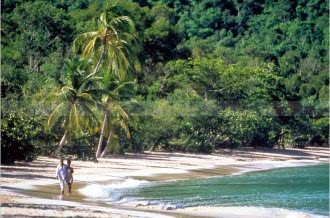 |
| Magens Bay St. Thomas © U.S. Virgin Islands Department of Tourism |
Weather in the U.S. Virgin Islands is warm all year with a wet season and a dry season.
The islands are located in the eastern Caribbean and are a popular stop for cruise lines.
The most popular time of year to visit the Virgin Islands is between December and May, and with good reason. This is the nation's dry season.
The Dry Season
The dry season in the U.S. Virgin Islands runs from December to May. During this time, the islands receive very little rain, and there is little threat of hurricanes.Between December and May, the islands receive less than two inches of rainfall per month.
Most of this rainfall occurs in the form of a light, passing shower, meaning that visitors can expect warm, sunny days, with little rain to foil their plans.
During the dry season, rain is most likely to occur mid afternoon, often acting as a refreshing cool down for tourists.
Temperatures during the dry season average at around 85 degrees. High temperatures rise to 87 degrees Fahrenheit, and low temperatures drop to the mid seventies.
A warm, constant breeze is continually present on the island, making the temperatures feel slightly cooler and more comfortable.
The dry season is also the peak of the tourist season for the U.S. Virgin Islands, meaning hotels, beaches, and other attractions can become crowded. Visitors traveling during these months will benefit from booking their hotels and excursions in advance.
The Wet Season
The wet season, also known as the hurricane season, officially runs from June to November. Hurricanes are most likely to hit in the late summer and early fall.Tourism drops during this time of year, meaning that prices and crowds also drop.
The Virgin Islands receive nearly 30 inches of their annual 40 inches of rainfall during these months.
In September and October, rainfall increases to six inches per month.
Much of this rain can occur in the form of a tropical storm or hurricane. Visitors brave enough to travel to the Virgin Islands during this time of year should check for weather advisories.
Heavy rainfall makes September the least popular month to visit the U.S. Virgin Islands.
Temperatures during the wet season rise to the low 90s.
July and August are the hottest months, with temperatures rising to 90 degrees Fahrenheit.
Low temperatures drop to the mid 70s. In November, the average low temperature is 75.1 degrees.
Early months during the wet season, such as June and July, can still be calm enough for an enjoyable visit. Later months become more difficult, as the increase of hurricanes increases.
No comments:
Post a Comment